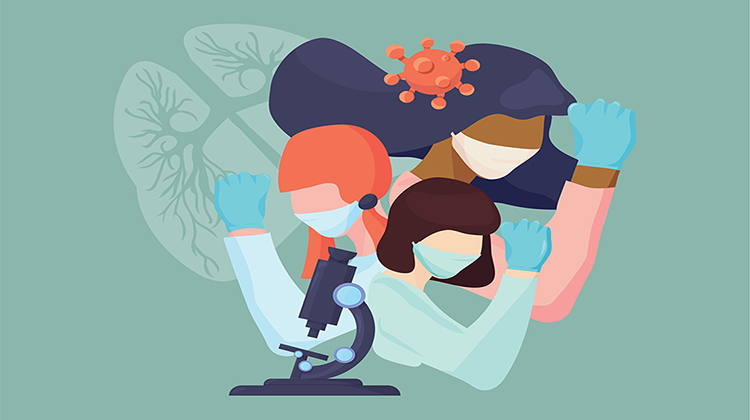Women in Stem with Leila Jaafar
Posted: 5 March 2024 | Leila Jaafar (NUCLIDIUM AG) | No comments yet
After gaining her PhD in Biophysics as an International Max-Planck Research School scholar, Leila joined the nuclear field in 2006, starting as an engineer in radiation protection and neutron fluence. Throughout Leila’s career, she has worked across multiple disciplines as a technical project lead in nuclear engineering, lastly in the production of radionuclides. Before founding NUCLIDIUM in 2017, Leila was active as a programme manager in the worldwide development of infrastructure for radionuclide production.
As CEO, Leila focuses on shaping and the execution of NUCLIDIUM`s international strategy towards its primary goal of improving the availability and affordability of radiopharmaceuticals in cancer diagnosis and therapy worldwide.


Can you tell us about your journey in the field of STEM and the challenges you encountered along the way?
My STEM journey began early in my childhood, thanks to my father, a mathematician and economist whose job took him around the globe. He would return from his travels with an assortment of magazines, often including a scientific journal in the mix. We’d delve into these articles together as soon as he came home, dissecting complex topics like string theory and the Big Bang into digestible, child-friendly explanations. Over the years, these discussions grew in complexity. My intellectual pursuits were always encouraged equally to those of my brothers, fostering a deep-seated fascination with the natural sciences early on.
The first true test of my commitment came with my PhD in Biophysics as a scholar at the International Max-Planck Research School, specifically when I became pregnant with my first child in 2006. I was the only expectant mother on the faculty in a predominantly male environment, and returned to work ten weeks postpartum, only to discover my project had been reassigned due to my supervisor’s doubts about my return.
Starting from scratch two years into my program was daunting. Still, with the help of a nanny and the moral support of my colleagues, I managed to balance motherhood and my studies. Despite societal pressures and being labeled as a neglectful “Rabenmutter” (“raven mother”), a derogatory German term for career-focused mothers, I connected with other women at the university who faced similar challenges. We were all united by our passion for our respective fields.
What inspired you to pursue a career in STEM, and how did you overcome any obstacles or biases you may have faced?
Pursuing a career in STEM felt like a natural progression for me. Following my Ph.D., I embarked on a role as a radiation protection and neutron fluence engineer at a German subsidiary of a prominent French nuclear engineering firm. I was not only one of the few women in a department overwhelmingly dominated by men but also the only woman in my group.
Much like any other engineering field in Germany, nuclear engineering is a male-dominated industry characterised by an ageing demographic. My entry into this space was quite a novelty. My senior male colleagues, unaccustomed to having a woman as an equal in the workplace, often hesitated to include me in onsite assignments at nuclear plants, assuming that, as a mother, I would prefer to avoid travel. The facilities, including changing rooms at nuclear sites, were ill-prepared at times. Despite these challenges, I made it a point to voice my desire to participate fully in all aspects of our work. My innate curiosity served me well, prompting me to seek knowledge and advice from my more experienced colleagues, who were generally happy to share their expertise with someone eager to learn.
By the time I had my second daughter in 2012, childcare options had significantly improved, though societal attitudes lagged. My workplace and colleagues had grown accustomed to my ‘unconventional’ approach, and I sensed their growing respect for my ways. I took on larger projects and made sure my voice was heard, despite an ever-present fear of being overlooked or not succeeding.
Could you share an example of a specific project or research that you have worked on and the impact it has had in your field?
Leveraging my diverse expertise in biophysics and nuclear engineering proved beneficial as my career progressed. I was selected to lead initiatives aimed at generating and extracting radionuclides from the nuclear supply chain for the medical industry. My role became especially important when closures of aging nuclear reactors, such as NRU at Chalk River, resulted in serious supply crunches for radionuclides. These materials are essential for producing radiopharmaceuticals crucial to diagnosing and treating cancer. Subsequently, I took on the role of technical project leader, focusing on modifying existing machinery within commercial nuclear power plants to enable the production of medical radionuclides. My contributions to this field led to co-authorship on several patents related to this production technique.
How has your research in STEM contributed to advancements or improvements in your field, and what potential future applications or implications do you foresee based on your work?
My work on innovative production techniques for radiopharmaceuticals has been implemented in at least three commercial power plants to produce radionuclides for cancer therapy, with plans to extend its application to numerous other facilities worldwide. The significant impact of radiopharmaceuticals on treating solid tumours has attracted billions in investment and has led to major acquisitions by pharmaceutical giants over the past decade. Historically, producing radionuclides efficiently has been a major challenge and hurdle in the supply chain. Looking ahead, the advent of new technologies and alternative methods of production, such as the accelerator production technique being developed by my company, Nuclidium, promises to overcome these supply issues. This breakthrough has the potential not only to spur further research in the field but also to make this revolutionary treatment widely available to patients across the globe. Our vision for the near future is to see cancer treated as a manageable chronic condition, with minimal side effects for those affected.
As a woman in STEM, what unique perspectives or strengths do you believe you bring to your work?
From my perspective, the unique challenges women face in the workplace often lead us to adopt a much more thorough approach to our assignments. I’ve observed that my colleagues who are women, not only possess a comprehensive understanding of their responsibilities but also exhibit deep scientific expertise. Our capacity to alternate between detailed and holistic perspectives renders us versatile. This blend of broad awareness and meticulous attention to detail proves invaluable in various contexts, particularly in strategic decision-making.
What advice would you give to young women who are considering a career in STEM but may be hesitant due to societal stereotypes or perceived challenges?
Impostor syndrome is a pervasive occupational hazard that affects many women in STEM, acting as a significant barrier to career advancement. Virtually every colleague I’ve encountered who is a woman, regardless of field or career stage, has experienced it in various degrees of severity. Despite accumulating degrees and professional credentials, we often question our capabilities due to societal stereotypes and a fear of judgment or failure. This fear can prevent us from seizing opportunities, leaving us to wonder, “what if?” As Susan Jeffers famously advised, the best approach is to “Feel the Fear and Do it Anyway.” Cultivating a strong sense of curiosity can help navigate the challenges and competitive nature of STEM fields. Viewing competition as a chance to deepen our knowledge and expertise is invaluable. It’s crucial to find joy in the process and not base our sense of achievement solely on attaining future goals. Learning is a continuous journey with immediate rewards. Furthermore, building a robust network with both men and women is essential, regardless of personal affinities. Success of women in STEM requires overcoming these psychological barriers and embracing every opportunity for growth and collaboration.
How do you see the representation of women in STEM changing over the years, and what further progress do you believe is needed?
In STEM education in the USA and UK, the percentage of female undergraduates varies, with as few as 20 percent in physics and up to 40 percent in chemistry, all indicating a clear underrepresentation of women. Research reveals that female scientists face more hurdles than their male counterparts, such as being ignored when inquiring about Ph.D. positions, needing to publish more papers in prestigious journals to secure equivalent academic positions, and a higher likelihood of leaving their careers due to harassment. The additional strain of confronting diversity issues, on top of everyday challenges in both academic and corporate environments, can be isolating and downright exhausting. While improvements in childcare, maternity leave, and affirmative action are vital, I believe encouragement should begin much earlier, incorporating both women and men as role models. The question remains: Can women in STEM be seen as positive and inspiring role models while navigating through barriers like the glass ceiling and minimal support at home? Will fathers engage their daughters in discussions about the joy that can be found in math and science? From an early age with our children, we need to dispel the myth of the lonely, inaccessible ‘genius’ physicist or mathematician in that ivory tower and highlight the attainable possibilities of using our imagination and creativity in these subjects.
In your opinion, what can organisations and institutions do to create a more inclusive and supportive environment for women pursuing STEM careers?
Finding the perfect timing for parenthood is elusive; hence, the present moment is as good as any for starting a family. For numerous young women at the onset of their careers, particularly those far from their familial support systems and without the means for full-time childcare, the idea of having children might seem unfeasible. Therefore, the top priority should be ensuring affordable access to childcare and care for mothers, accommodating not only healthy children but also those who are ill, as well as sick mothers. I was fortunate to benefit from a subsidised programme as a full-time employee, which provided a team of nannies to look after both my child and me during illness at home. Our nanny, initially hired for a short-term period, became an integral part of our family over the years. There needs to be a shift in mindset. Family care is not just an incentive to alleviate an acute situation but a real investment into the workforce of highly qualified individuals equivalent to on-the-job training.
About the author


CEO and Founder, NUCLIDIUM AG
After gaining her PhD in Biophysics as an International Max-Planck Research School scholar, Leila joined the nuclear field in 2006, starting as an engineer in radiation protection and neutron fluence. Throughout Leila’s career, she has worked across multiple disciplines as a technical project lead in nuclear engineering, lastly in the production of radionuclides. Before founding NUCLIDIUM in 2017, Leila was active as a programme manager in the worldwide development of infrastructure for radionuclide production.
As CEO, Leila focuses on shaping and the execution of NUCLIDIUM`s international strategy towards its primary goal of improving the availability and affordability of radiopharmaceuticals in cancer diagnosis and therapy worldwide.
References
- Data on women in physics [Internet]. Nature Publishing Group; 2019 [cited 2024 Feb 23]. Available from: https://www.nature.com/articles/s42254-019-0061-3
- Jamieson V. Women in physics: Why there’s a problem and how we can solve it [Internet]. New Scientist; 2019 [cited 2024 Feb 23]. Available from: https://www.newscientist.com/article/mg24032031-900-women-in-physics-why-theres-a-problem-and-how-we-can-solve-it/
Related topics
Drug Delivery, Drug Development, Drug Discovery, Targets
Related conditions
Cancer
Related organisations
NUCLIDIUM AG
Related people
Leila Jaafar (NUCLIDIUM AG)








